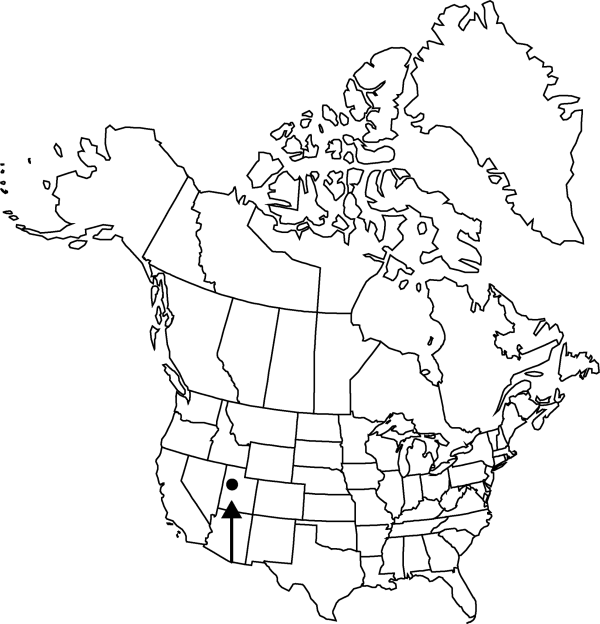Difference between revisions of "Atriplex canescens var. gigantea"
Great Basin Naturalist 44: 189. 1984.
FNA>Volume Importer |
FNA>Volume Importer |
||
| Line 24: | Line 24: | ||
|elevation=1400-1600 m | |elevation=1400-1600 m | ||
|distribution=Utah. | |distribution=Utah. | ||
| − | |discussion=<p>Atriplex canescens var. gigantea occurs with scurfpea (Psoralidium lanceolatum), ricegrass (Stipa hymenoides), and other dune plants. Occasional plants with very large bracts occur as far south as El Paso County, Texas. The chromosomal status for Atriplex canescens var. gigantea is unknown, however, and is evidently unusual in the species in being diploid. The population in Juab County, Texas, occurs in active sand dunes and accommodates the change in depth of sand by rooting (i.e., layering) along the buried portions of the stem (H. C. Stutz et al. 1975). Actual plant length below the sand surface is often much greater than that showing above the surface.</p><!-- | + | |discussion=<p><i>Atriplex canescens </i>var.<i> gigantea</i> occurs with scurfpea (Psoralidium lanceolatum), ricegrass (<i>Stipa</i> hymenoides), and other dune plants. Occasional plants with very large bracts occur as far south as El Paso County, Texas. The chromosomal status for <i>Atriplex canescens </i>var.<i> gigantea</i> is unknown, however, and is evidently unusual in the species in being diploid. The population in Juab County, Texas, occurs in active sand dunes and accommodates the change in depth of sand by rooting (i.e., layering) along the buried portions of the stem (H. C. Stutz et al. 1975). Actual plant length below the sand surface is often much greater than that showing above the surface.</p><!-- |
| − | --><p>Atriplex canescens var. gigantea is in the Center for Plant Conservation’s National Collection of Endangered Plants.</p> | + | --><p><i>Atriplex canescens </i>var.<i> gigantea</i> is in the Center for Plant Conservation’s National Collection of Endangered Plants.</p> |
|tables= | |tables= | ||
|references= | |references= | ||
| Line 49: | Line 49: | ||
|publication year=1984 | |publication year=1984 | ||
|special status= | |special status= | ||
| − | |source xml=https://jpend@bitbucket.org/aafc-mbb/fna-data-curation.git/src/ | + | |source xml=https://jpend@bitbucket.org/aafc-mbb/fna-data-curation.git/src/8f726806613d60c220dc4493de13607dd3150896/coarse_grained_fna_xml/V4/V4_754.xml |
|genus=Atriplex | |genus=Atriplex | ||
|subgenus=Atriplex subg. Pterochiton | |subgenus=Atriplex subg. Pterochiton | ||
Revision as of 17:30, 18 September 2019
Plants mainly 10–20 dm, not especially armed, commonly layering. Pistillate flowers borne in panicles 5–40 cm. Fruiting bracteoles on stipes 18, body with 4 prominent, dentate to entire wings extending length of bract, united throughout, mainly 15–25 mm wide and about as long, apex toothed, surface of wings and body smooth or reticulate. Seeds 1.5–2.5 mm wide. 2n = 18.
Phenology: Flowering summer–fall.
Habitat: Active sand dunes
Elevation: 1400-1600 m
Discussion
Atriplex canescens var. gigantea occurs with scurfpea (Psoralidium lanceolatum), ricegrass (Stipa hymenoides), and other dune plants. Occasional plants with very large bracts occur as far south as El Paso County, Texas. The chromosomal status for Atriplex canescens var. gigantea is unknown, however, and is evidently unusual in the species in being diploid. The population in Juab County, Texas, occurs in active sand dunes and accommodates the change in depth of sand by rooting (i.e., layering) along the buried portions of the stem (H. C. Stutz et al. 1975). Actual plant length below the sand surface is often much greater than that showing above the surface.
Atriplex canescens var. gigantea is in the Center for Plant Conservation’s National Collection of Endangered Plants.
Selected References
None.
